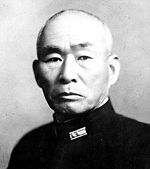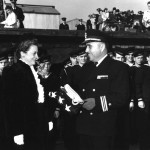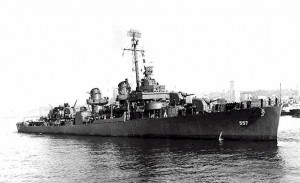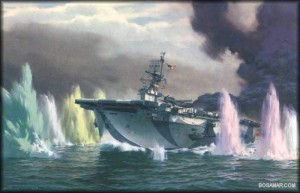“The Ultimate of Desperate Circumstances”: The Battle off Samar
Sunday, October 25, 2009
posted by Deuce Richardson
 Print This Post
Print This Post
The Battle off Samar, thus unexpectedly joined at 0648 (on October 25,1944), was the most remarkable of the Pacific war, since the tactics had to be improvised.
–Samuel Eliot Morison, from The Two-Ocean War
It was difficult deciding what battle to commemorate today. I finally settled on the Battle off Samar for several reasons. One reason is that it was just one helluva scrap. Another being that Samar, and the Battle of Leyte Gulf which encompassed it, is largely neglected and/or forgotten, even by many who consider themselves “World War Two buffs,” this despite the fact that the events centered upon the Gulf of Leyte ended up breaking the Imperial Japanese Navy. The awe-inspiring bravery of the men at Samar warrants remembrance on this sixty-fifth anniversary of the battle.
By sheer happenstance, Morison’s The Two-Ocean War, which is a one-volume “greatest hits” drawn from his magisterial History of the United States Naval Operations in World War II, fell into my hands yesterday. Morison is a good writer and quite knowledgeable. I’ll be quoting extensively from his work.
The Battle off Samar was itself part of the even larger Battle of Leyte Gulf, possibly the largest naval engagement in the history of this planet. Keeping track of the great numbers of men and war machines involved can be pretty daunting. My intent is to focus on a few incidents of transcendant bravery. For the “big picture,” Robert Jon Cox’s website and the wikipedia entry are both excellent.*
In simple terms, on the morning of October 25, 1944, three US Navy Task Units (designated “Taffy 1,” “Taffy 2” and “Taffy 3”) were stationed to the east of the Phillipine Islands. The Task Units were comprised of small escort carriers with (in the case of Taffy 3) accompanying destroyers and destroyer escorts. A little before 7 a.m., the commander of Taffy 3 learned that he had an Imperial Japanese fleet bearing down upon him from the north. The Yamato was part of that fleet, one of the two largest battleships in the world. Its displacement was as much as all of Taffy 3’s ships combined.

Takeo Kurita
The Japanese fleet (known as “Center Force”) was commanded by Vice Admiral Takeo Kurita. His fleet had been on the move for seven hours, unopposed. This was due to USN Admiral Halsey allowing himself and his ships to be decoyed to the north, thus leaving the three Task Units totally unsupported against a much more powerful Japanese fleet. Taffy 3, commanded by Rear Admiral Clifton Sprague, was to bear the brunt of Kurita’s assault.
Sprague’s Task Unit was composed of six small, poorly-gunned escort carriers equipped with comparatively old, slow fighters and torpedo planes. His six carriers were accompanied by three destroyers and four destroyer escorts. In contrast, Kurita commanded thirteen destroyers, six cruisers and four battleships, including the mammoth Yamato. In very rough terms, the Japanese force enjoyed a 10:1 advantage in tonnage and gunnery over the Americans.
As Morison noted above, Clifton Sprague had no training or manuals to fall back on in this situation. The US Navy never envisioned training its officers to deal with such a far-fetched mismatch. Sprague quickly decided to save the carriers if possible (that being his primary responsibility), using his destroyers, destroyer escorts and carrier aircraft as a defensive screen to cover the withdrawal. However, the fact that his carriers were significantly slower than the pursuing Japanese warships meant that even such a partial escape was by no means assured. Sprague sent out the order to launch all aircraft and for all destroyers and destroyer escorts to engage the enemy.
Commander Ernest E. Evans, skipper of the destroyer, Johnston, was  already doing just that. Morison says this of Evans:
already doing just that. Morison says this of Evans:
(He) was a fighting Cherokee of the same breed as “Jocko” Clark — short, barrel-chested, loud of voice, a born leader. As soon as the Japanese ships were sighted he ordered all boilers to be lighted, called all hands to General Quarters, and passed the word, “Prepare to attack major portion of the Japanese fleet.”
While laying a smoke screen to protect Taffy 3’s carriers, Evans and his crew moved in to attack an entire heavy cruiser column, a move analogous to a pit bull assaulting a pride of lions. At 7:20 a.m. the Johnston fired off its entire complement of torpedoes at the heavy cruiser Kumano, scoring three hits and forcing the warship from the fight.
Immediately after, the Johnston took numerous hits from the cruisers and approaching battleships, knocking out power to the guns and leaving only one engine functional. Additionally, three officers on the bridge were killed and Evans lost fingers on his left hand, on top of receiving shrapnel wounds. At that moment, the Johnston managed to duck into a rain squall within which the escort carriers had already taken sanctuary. Emergency repairs were made and the Johnston headed back out of the squall to reengage Center Force. Evans and his men weren’t done fighting.

The USS Johnston
The Johnston, out of torpedos, began firing on the battleship Kongo, matching her (now) manually-controlled 5-inch guns against the 14-inch guns of the massive Japanese warship. After Kongo was distracted by fighter attacks, Evans turned his ship toward a destroyer squadron heading for Taffy 3’s carriers. The Johnston engaged the entire squadron alone and without orders, scoring twelve hits on the squadron flagship Yahagi and forcing a premature launch of the squadron’s torpedos, thereby disrupting the entire attack.
At that point three Japanese cruisers and several destroyers overtook the nearly-crippled Johnston, pouring on salvo after salvo. One survivor later stated that the skipper of the Japanese destroyer which moved in to deliver the coup de grace saluted the Johnston as she went down.
Commander Ernest E. Evans was posthumously awarded the Congressional Medal of Honor.
Admiral Kurita had been waging the entire battle with the misapprehension that he was up against full-sized carriers and that the destroyers that were giving him such trouble were cruisers. Taffy 3 had truly been fighting above its class. Kurita was commanding a fleet that had just seen three heavy cruisers sunk and three more seriously damaged in just two hours. He believed that his warships had already sunk or damaged several carriers and he had received faulty intelligence informing him of another US fleet to the north. At 9:25 a.m., Kurita gave the order for withdrawal.
A little over two hours after the battle officially began, Center Force was steaming back northward. When the signalman on Sprague’s flagship Fanshaw Bay saw the Japanese fleet turning about, he yelled, “Goddammit, boys, they’re getting away!” The most powerful gunfire force which Japan had sent to sea since the Battle of Midway had been stymied at the cost of 1130 American lives. Never again would the Imperial Japanese Navy seek a major engagemant with the US fleet.
Samuel Eliot Morison had this to say:
The Battle for Leyte Gulf did not end the war, but it was decisive. And it should be part of our national memory. The night action in Surigao Strait is an inspiring example of perfect timing, coordination and almost faultless execution. And the Battle off Samar had no compeer.The story of that action, with its dramatic surprise, the quick thinking and resolute decisions of Clifton Sprague; the little screening vessels feeling for each other through the rain and smoke and, courting annihilation, making individual attacks on battleships and heavy cruisers; naval aviators making dry runs on enemy ships to divert gunfire from their own; the defiant humor and indomitable courage of the bluejackets caught in the “ultimate of desperate circumstances,” will make the fight of the “Taffys” with Kurita’s Center Force forever memorable, forever glorious.
The memorial to Vice Admiral Clifton Sprague
*A most excellent video overview of the Battle off Samar can be viewed here.


